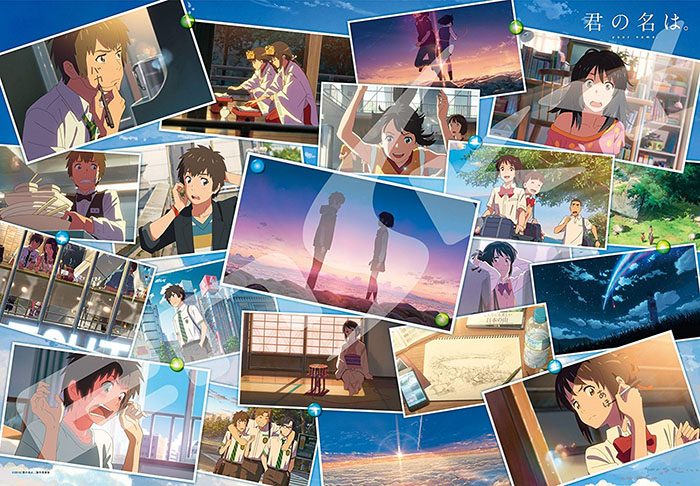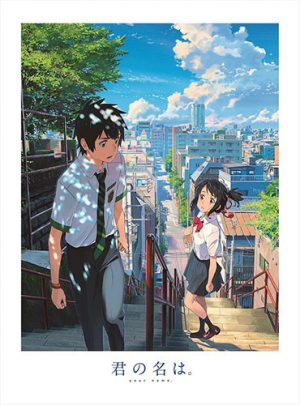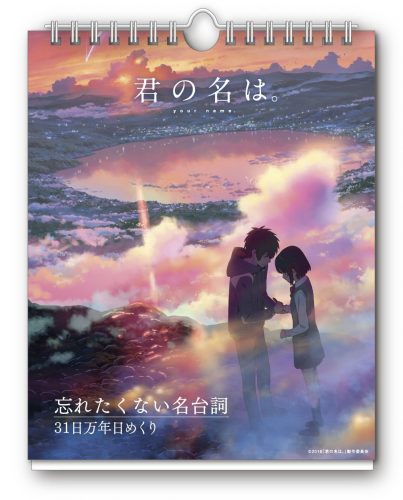
Kimi no Na wa (Your Name) is Makoto Shinkai’s most recent film. Debuting internationally, the movie’s success is undeniable, grossing a profit of over 350 million dollars.
By bringing attention to its editing, reinforcing visuals with dialogue, and creating themes through repetition, Shinkai stylizes repetition, fashioning a film easily appreciated and understood by a wide audience.
For this article, I’ll be working through multiple scenes in the movie. By walking through scenes, I hope to provide examples of Shinkai’s style, allowing readers to understand the director’s intentions and technique.
Making Overtness a Style: Editing and Molding Film Language

When reviewing films, one of the most important aspects is editing. Editing is where subtlety can emerge—where things unstated can be understood. One school of thought believes editing should be an invisible hand that guides the viewer. However, there are times when editing should bring attention to itself, and Your Name does this with 2 types of transitions.
Door-opening transitions are an obvious segue with a wealth of associations. When a distinct “before-and-after needs to be established, these transitions can show characters entering a new world, mindset, or perspective. Some examples are:
- The train door transition when Taki wakes up from his dream and into Mitsuha’s body, ending with a literal cut of a tomato, a visual transition into breakfast.
- After Mitsuha learns that “she” made a scene in art class, she rushes into her house—door transition— and into her room—door transition. She desperately searches her diary to see if there is a clue for “her” peculiar behavior. Flipping through the pages of her diary, she sees someone else’s perspective on her life.
Cellphone transitions indicate time has passed. By having the shot focused on a cellphone’s calendar, a swipe from right to left shows going back a day. These transitions are commonly done when a song begins or ends, followed by a cut to the next scene upon swiping. A derivative of these would be the cellphone photograph transitions. These center a character’s interest by “framing it” within a camera. This transition allows a personal look into a character while also indicating time has passed. Examples of both include:
- When Miki, Taki’s coworker, calls him by his name affectionately, Taki responds with surprise. He is unaware of what happened that changed his relationship. A cell phone swipe is then used to end the scene, as we transition to Mitsuha.
- In order to contrast the previous scene, after the swipe, Mitsuha walks into her class. Her classmates stare at her in shock, and her friend tells her “Well, you made quite a scene yesterday.” Another cellphone swipe transition is used, showing the audience what happened. She learns that “she” made a scene in art class, kicking over an art stand in response to snide comments.
- After Mitsuha flips through her diary, panicking at all the comments Taki left for her, a cell phone swipe moves us to Taki’s perspective. He is “flipping through his calendar” to check the comments left by Mitsuha.
- When Mitsuha is in Taki’s body, she goes to a cafe. Here, she eats sweets, but before doing so, she takes a picture of her meal. In a sort of “jump cut,” the act of eating the meal is taken out, but when the cellphone camera “pans down,” the food is finished.
Door transitions are throughout Your Name. These doors are open during youth and, sentimentally, open during adulthood. Both cellphone transitions appear early when characters are more fixated on their cellphones. However, these transitions leave later. In exchange, the idea of a cell phone has been established; it’s a tool to connect people beyond distances.
Aptly, when both Taki and Mitsuha become more intimate, Taki wants to call Mitsuha and hear her voice. Before, they communicated through text. However, at this point in the film, the call doesn’t reach. The distance between the two isn’t physical. In fact, it’s been hinted at already. The difference is time.
Restating Visual Information with Dialogue
Your Name is a PG film. Ideally, this means the film’s visual language is understandable to different age groups. To do this, Shinkai reinforcing visuals with dialogue.
When Taki is in Mitsuha’s body, he visits the shrine. After exiting, Mitsuha’s grandma asks if he’s dreaming. He wakes into his own body. Dazed and confused, he notices tears in his eyes.
Before he can figure things out, he notices a comment on his phone: Mitsuha has set up a date with his crush and coworker, Miki. He rushes out of his room to make it in time. After he goes on the date, the movie cuts back to Mitsuha, now in her body. She is seen crying. Now, the audience knows she was the one crying before the body swap. The reason is implied, but the film explains soon.
On their date, Miki and Taki go to a museum exhibition. Its theme, nostalgia. Framed on the walls are black and white photographs of Mitsuha’s hometown. However, Taki doesn’t make the connection—this town no longer exists. Before he understands, Miki walks out of the frame, a distance that implies she’s not connecting with Taki.
After the museum, Taki and Miki are on a bridge. Taki chases up to her. Trying to close the emotional distance physically. Taki invites her to dinner, “Um, senpai. Are you hungry? How about dinner?” She responds, “Let’s call it a day.” He stops in the middle of the bridge, the light divides the two. She continues, “Taki, you… Sorry if I’m wrong. You used to have a bit of a crush on me, right? But now you like someone else.”
He tries to hide his emotions, but the audience and Miki already know the truth. After all, the film goes through great lengths to forge a physical and emotional connection between Taki and Mitsuha. Thus, this is restating information.
When Miki leaves, Taki calls Mitsuha. The film cuts to Mitsuha, and we see from her perspective. The camera starts from below and pans upwards towards her shoulders. Her formerly long hair no longer reaches her shoulders.
Once more, the film explains if you didn’t understand. When Mitsuha walks to the festival, her friends show a shocked expression. Her hair has been cut. Tessie comments, “You think some guy is the reason? Ditched, maybe?” Again, this clarifies any confusion on why she was crying and also the reason for her hair’s length.
When she and her friends get to the top of the mountain, they see a portion of the comet break off. This shot mirrors an early scene in the movie. As the broken piece closes in, the camera zooms into Mitsuha’s eyes. The film cuts back to Taki on his phone. His call doesn’t make it through.
When visual information is clarified through dialogue, it can be helpful. On one hand, repeating information clarifies things, providing aid to those who might have missed a small detail. On the other hand, repeating information might waste a dwindling resource, time.
The tone of repetition can quickly change. What might be a gentle reminder can become a pestering annoyance on the third or fourth occurrence. There are times when Your Name pushes this too far, however, the film changes the nature of repetition with a strong payoff. By borrowing from earlier scenes, Shinkai turns repetition into a theme.
Adhering to a Theme: the Payoffs of Setup
Often, Shinkai associates a mental idea with a physical object. Through this, he can associate something intangible with something concrete. This creates and associates a character’s mental state with something more easily understood, allowing for an easier understanding of Shinkai’s films.
Once the audience understands one image, he repeats scenes and images, slowly transforming the image’s meaning. At the beginning of the film, Mitsuha’s red ribbon is ephemeral. Before Taki can understand Mitsuha’s true identity, he wakes up. His “dream” quickly passing through his thoughts.
As the film continues, her red ribbon becomes associated with several other ideas. First, it’s something that’s meant to reunite the characters. The physical action of returning the ribbon will bring them closer. Second, the ribbon is an identity marker. Mitsuha is associated with musubi, an “old term for calling the local guardian deity.” According to her grandma, a musubi is multiple things. It is a “Tying thread… connecting people… the flow of time… These are all the God’s power.” As she’s explaining this, the camera shows the surrounding trees, all tied by a rope.
This develops a previous scene when the grandma explains why they weave fabric— their religious texts burned in a fire. To preserve tradition, they continue to weave fabric, to bind things before they fade away. Like the bracelet she made for Taki and like her hair, both are bound by fabric. Both are also fading from each other’s memories.
When Taki finds out Mitsuha is from the past. He rushes to the shrine where her family placed sake as an offering. He drinks from it and slips as he walks. He falls into a surreal underwater sequence. There, he sees the fabric imagery evolve. In this sequence, his bracelet is tied by a red string.
The red string starts out as a comet’s trail. This trail links the characters in the film’s beginning, and the breaking apart of comet, to put it lightly, disconnects the characters. This trail, evolves into the familiar red string, expands, and shows a comet hitting land, creating the Itomori lake.
Later in the film, we’re shown the aftermath of this comet, an “8” symbol, conveniently reminding viewers of two things: the number of years that passed since Itomori’s destruction and a visual reminder the themes of eternal bonds.
Continuing, the comet’s explosion erupts the water, forming cells that form an umbilical cord. This cord shows the family’s history/bloodline. As the doctor cuts the cord, the next scenes show the birth of the child and eventually the mother dying. This is the “cutting of life.” With the mother gone, the cutting image gets expanded.
The husband grieves for his loss, “cutting” himself away from his family. His isolation, however, renews the grandma’s determination. She promises to be with her two granddaughters.
The camera zooms out, showing recent events: when Mitsuha ties her hair, realizing she loves Taki, when she goes to Tokyo to see him and he fails to recognize her, when she cut her hair and unbinds the ribbon that connects them, when she wears a kimono with a distinct red fabric around her waist, and finally the scene of the comet when it hits Itomori.
Shinkai’s repetition becomes a circle, connecting the present to the past, uniting the lovers through a bond. This bond persists throughout the film, evolving as it cycles through different forms. Even with time and distance against them, even with their memories fading against their wishes, they hold onto this fleeting feeling, this emotion they want to express loudly.
In the film’s final moments, as the lovers are about to pass each other, they turn around, each inhabiting the spots where the other once stood. Fighting against their fears, they finally meet and express their emotions.
“Hey, haven’t we met?” Taki asks.
“I thought so, too!” She says, tears in her eyes.
Together, they pronounce the film’s title: Your Name.
Final Thoughts

I’ve grown up with Makoto Shinkai films. His views on romance influenced my own, giving me some of my fondest childhood memories. Given his influence, it felt strange to me I’ve never written an article about him. I’m glad that’s been fixed with this article. Hopefully, this piece has given you some insight into his directing style and you come away with an appreciation for his work.
Recommended Post



